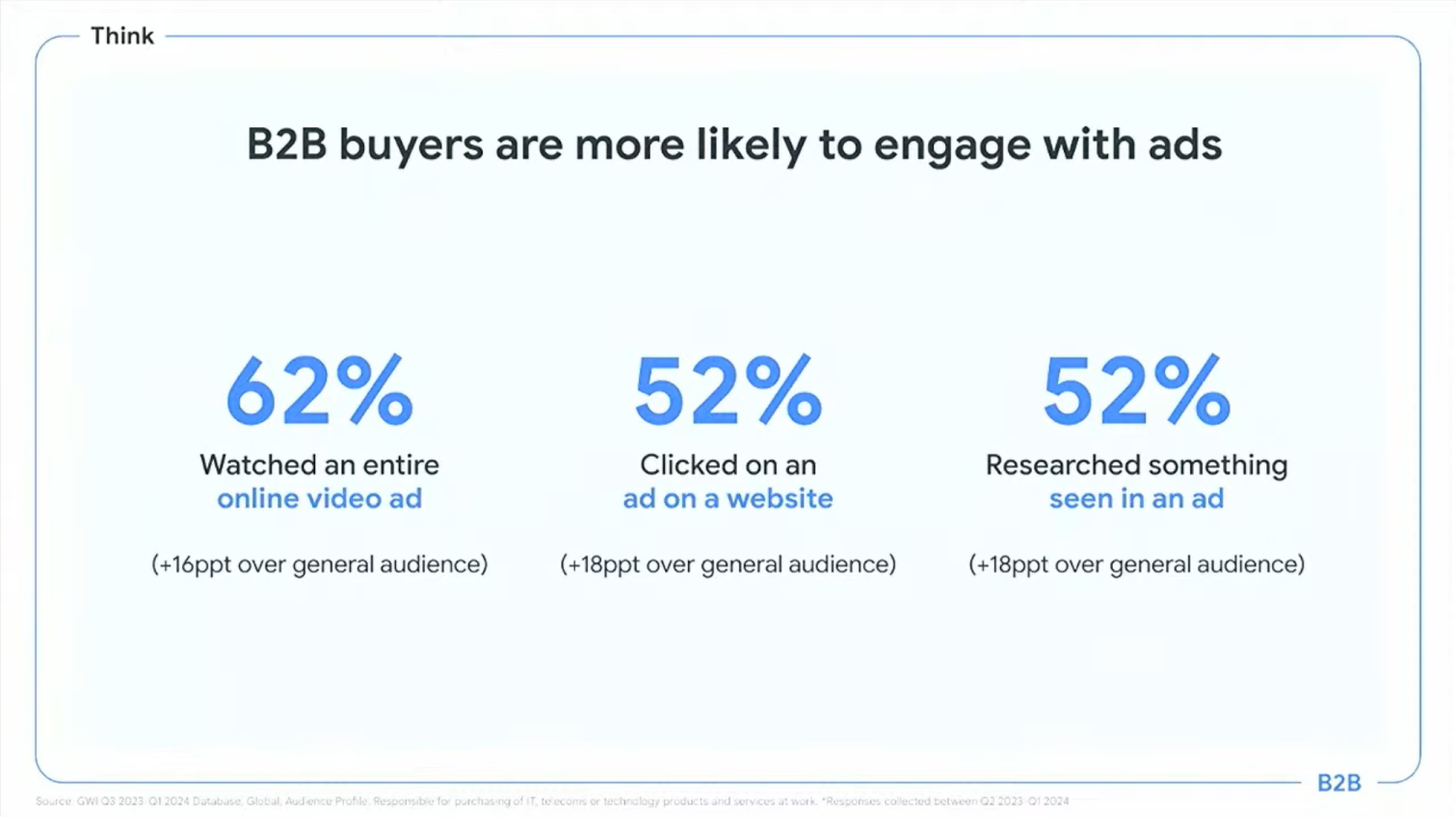Google Think B2B is an annual event and platform where Google shares insights, data, and strategies tailored specifically to B2B marketers. This year’s keynote underscored significant shifts in how B2B companies must adapt to a digital-first world where buyer autonomy reigns supreme. One of the keynote's focal points was that self-directed purchasing now dominates the B2B landscape, with over 90% of buyers preferring to complete their research before initiating contact with a salesperson. This insight aligns with the B2B strategies we’ve been implementing for our clients, further validating the importance of providing high-quality, accessible digital content that empowers buyers to make informed decisions on their own time.
The Changing Role of Marketing and Sales Collaboration
A key theme was the need for greater collaboration between marketing and sales teams. Google’s data revealed that the traditional linear funnel, where marketing hands off leads to sales, no longer aligns with current buyer behaviors. Instead, today's customer journey is non-linear, with buyers interacting across multiple touchpoints before making a decision. Google stressed that to meet these new expectations, marketing and sales teams must collaborate more closely than ever, ensuring consistent value and engagement across channels—whether through video content, webinars, social media, or search.

We often emphasize the importance of brand and demand generation together and now Google has introduced a similar concept, called "building future demand." This concept mirrors the well-known 95/5 rule—where only 5% of businesses are actively in the market at any given time. The key is engaging the remaining 95% so that your brand stays top-of-mind when they do enter the market.
The Power of AI and Data Analytics in Personalizing Engagement
AI and data analytics are emerging as essential tools for understanding customer behavior and personalizing engagement. With the increasing complexity of the buyer journey, AI-driven insights help companies refine their strategies by identifying the most effective messaging and formats to capture and nurture leads. Google encouraged businesses to adopt multi-channel approaches, leveraging platforms like YouTube, LinkedIn, and industry-specific channels to meet buyers wherever they are.
B2B Buyers are More Engaged with Ads

Google’s keynote revealed a compelling insight: B2B buyers are more likely to engage with ads compared to the general audience. Specifically, 62% of B2B buyers watched an entire online video ad, which is 16 percentage points higher than the general audience. Additionally, 52% clicked on an ad on a website and 52% researched something they saw in an ad—both 18 percentage points higher than the general audience. This data underscores the importance of investing in targeted, high-quality digital advertising that resonates with B2B buyers as a powerful tool for brand-building, rather than simply driving clicks.
Content Diversity–Meeting Buyers Across the Decision-Making Process
In 2024, content diversity is key. With many B2B customers consuming multiple types of content, Google pushed for a balance between informative articles, short-form videos, and interactive digital tools to maintain engagement across the decision-making process. These insights reflect how B2B marketing is becoming more holistic and increasingly similar to B2C, requiring marketers to remain agile in their approach.
The overarching message was clear: B2B brands need to rethink traditional methods, prioritize data-driven insights, and commit to seamless collaboration between marketing and sales teams to stay competitive in 2024 and beyond.
Key Considerations for Advertisers
As we look ahead, Google outlined several key considerations for B2B advertisers to stay competitive in 2024:
Structure and Scale: High-growth companies are testing Gen AI more than their low growth counterparts. These companies have shown that leveraging Gen AI for content is an effective growth strategy.
Leverage Experimentation: Businesses should embrace experimentation using Google’s automated technologies to test variables within their campaigns. Provided that experiments align with and contribute to specific business goals, testing opportunities such as ad creative, audience targeting, bid strategy, search query and keyword tests can power performance.
Activate First-Party Data: Investing and acting on first party data is key for maximizing investment through reaching high-value users and producing robust measurement solutions. In 2025, businesses should look to ingest and action more on first party data, segmenting signals that show intent at each level of the purchase journey.
AI-Driven Marketing: High-growth firms and business are more apt to adopt predictive AI for digital marketing. Tools such as AI powered bidding, AI for automated spend and budgets, creative, etc. accelerate growth potential.
Erica Barth leads Edelman DXI’s performance intelligence team in the U.S., where she creates innovative performance marketing and analytics strategies to drive business outcomes.
Vamsee Mahendrakar is a director within Edelman DXI's performance intelligence team in Canada. He leads performance marketing efforts at DXI Canada, crafting data-driven strategies across paid channels to drive impactful results for B2B and B2C clients.

